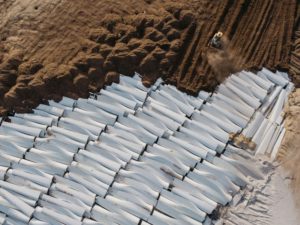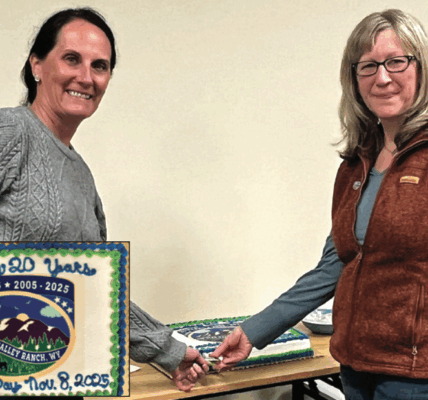By Greg Johnson
Gillette News Record
Via- Wyoming News Exchange

Photographer: Benjamin Rasmussen for Bloomberg Green
GILLETTE — The slow, steady turning of thousands of wind turbines continues to pace a revolution in the U.S. domestic energy generation portfolio, or perhaps millions of small revolutions.
With wind, solar and other green sources of electricity now making up the majority of America’s power generation, states are facing an increasingly worrisome dilemma of dealing with the massive amounts of waste created by the wind industry.
Now that wind has emerged as the nation’s fastest-growing energy sector, the gold standard for green energy is revealing a dirty secret of its own with massive amounts of industrial waste.
Although made of fiberglass to reduce weight and cost, the huge blades that rotate the turbines can be longer than the wing of a large jumbo jet and weigh more than 5 tons each. As the industry adds thousands of new turbines a year, the problem of disposing of worn-out parts and blades has escalated, especially for local municipalities.
When photos of thousands of used wind turbine blades at the Casper landfill went viral last year, local and state officials took notice, said state Speaker of the House Eric Barlow, R-Gillette. That’s because relatively small local governments like the ones in Wyoming can’t handle adding that volume of waste in their landfills for long.
As federal policies and tax incentives continue to spur wind development, Wyoming’s unique weather landscape will continue to make the Cowboy State a leader in building and expanding wind farms. And as residents have expressed concern about the impact those farms can have on landfills, Barlow was drawn to a simple potential solution.
He suggested burying the blades in the huge Powder River Basin coal pits as companies reclaim the land.
“Now, the state of Wyoming and communities pay to dig holes to bury refuse,” Barlow said. “I don’t know that we need to subsidize that for every material. This material is one that if we can get the transit situation down, we wouldn’t fill our municipal landfills with industrial waste.”
That’s what prompted Barlow to propose House Bill 129 in the last legislative session, which passed. The bill allows private coal producers to use inert waste created by the wind industry as fill for reclamation of the mines. Because the turbine blades are fiberglass and contain no harmful chemicals, there’s no danger to the environment to bury them in the pits.
“These are very difficult, high-cost recyclable materials to deal with, and they’re inert,” he said. “They’re not going to leech into the groundwater or anything.”
What they could do is give some struggling coal companies another way to make a little money while dealing with their reclamation obligations, Barlow said. Along the way, the state would get a 25% cut of anything the companies make on taking in wind energy waste.
“I’m not under any delusion this is going to change the prospect of a coal mine’s earnings,” he said. “It’s unfortunate we have coal mines slowing down, but every little bit counts.”
Barlow also hasn’t missed the irony involved with using coal mines to ease a problem for an industry that’s helping drive coal out of business.
“There is a little irony that the waste from the green energy is being disposed of by the fossil fuel industry,” he said.
The idea is one of those rare government proposals that could be as simple as it sounds. It’s also rare in that it has the support of both the Wyoming Mining Association and the Powder River Basin Resource Council, an environmental watchdog group.
While an interesting idea in theory, only time will tell if coal companies will participate, said Travis Deti, executive director for the Wyoming Mining Association.
Because participation would be voluntary, the bottom line likely will be the potential to earn a little extra revenue by charging wind energy companies to take their waste, he said. Then, there’s the cost of crushing the fiberglass down to make sure it’s stable in the long run. It also makes sense if companies can charge to take the waste to make up a percentage of its fill rather than buy fill dirt, which is the No. 1 expense for reclamation.
“We see it as an opportunity,” Deti said. “With wind energy, it doesn’t get a lot of press, but it generates a lot of waste and it has to be disposed of. We have these giant pits that have to be reclaimed.
“It’s a big problem, and if Wyoming coal producers can be part of that solution, it’s an option out there to help solve a problem.”
Along with the space to take quite a bit of wind energy waste, the Powder River Basin also already has extensive and established rail service. That makes it a destination to potentially take used turbines from other wind-heavy states like Iowa, Deti said.
It also has the support of the Wyoming Department of Environmental Quality, which enforces reclamation regulations in the state. Because none of the material is hazardous, the DEQ considers it as it would any other fill material, said Keith Guille, a DEQ spokesperson.
“These are pretty deep mines, so this is just fill and not hazardous waste,” he said. “All those technical concerns have been addressed.”
Because fill is the largest reclamation cost, Guille said taking in old turbines could be attractive for some operators.
“These mines have gotten really good at reclaiming not just a straight slope, but to recontour the area and make it look even better than when they found it,” he said.
Without the coal pit option, the alternatives in Wyoming are pretty slim.
“Where else will you take these (blades)?” Guille asked. “The other options are landfills, and then it’s up to the landfill if they’re permitted to take those types of materials.”
Surrounding states also should be interested in the coal pit alternative, Guille said. That’s because as wind power grows, the waste is becoming a big problem with some. There are places in Iowa where old turbines are just stacked like cordwood on vacant land.
After addressing some concerns its organization had, the Powder River Basin Resource Council said there’s a lot of potential for the idea, said Shannon Anderson, an agency attorney.
A key issue will be that the material is treated and crushed properly when it goes into the pits, she said. That’s because the last thing anyone wants is for a pit to cave in years or decades after the fact.
“What you don’t want is 20 years down the road for it all to fall in because when you did it they didn’t sit right,” she said.
While optional and it would be up to companies to set their own prices for disposing of the turbines, Barlow said he’ll be glad for it, especially with possibly taking waste from other states.
“When they’re retrofitting a big wind field in Washington or Oregon or somewhere, you can put half a dozen on a rail car and bring them back here and have them pull right up by the mine and drop them off,” he said. “We don’t know if this will actually be utilized, but it made sense to me to at least look into it.”






